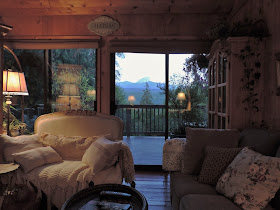Come along with me as we take a woodland walk
near my home in the Cascade foothills of Washington State.
Whitey Bear, one of my American Eskimos, leads the way.
Late afternoon light casts a soft glow.
My daughter's two mini-dachshunds
Peanut and Weenie-Baby :) tag along.
I am pet-sitting for the weekend.
Kai is also part of the pack,
but is too fast to capture in a group shot!
He's been known to come up so
fast from behind that he knocks her right over!
We are on the look-out for critters,
and today we have found five
for 'Five on Friday'
and
Saturday's Critters
The first critter we see through the gate,
as we get to the end of our country lane,
is a very healthy-looking cow elk.
She is lured by the neighbor's apple trees.
She is not too sure about us,
so takes one last look before she disappears
into the shadows.
We leave her in peace.....
The Black Cottonwood trees are starting
to drop their leaves, carpeting the ground
with a tapestry of burnished hues, providing
a thick mulch for plants below, such as these
Western Sword Ferns.
Black Cottonwood has a sweet, balsam scent
that is especially lovely this time of year.
These trees are the tallest, fastest growing
hardwood in the Western US and can
reach heights of up to 225 ft with a diameter
of up to 100 in.
In May they release their seed which fills
the air with tiny cotton tufts, hence their name.
The second wildling we see is the Douglas squirrel,
or Chickaree. These active and vocal little squirrels
eat seeds, mushrooms and fruits.
The cones of the Douglas Fir are a favorite.
The female has 4-6 young in early spring,
which will stay with her for most of their first year.
They especially love to 'scold' the dogs
as we walk below their tree.
Another favorite treat are the winged seeds of the
Big-Leaf Maple. They help to disperse
the seed by severing the clumps so they fall
to the ground for gathering.
Big-Leaf Maple gets its name for obvious reasons!
These are very large trees unsuitable
for the average backyard.
They frequently grow in clumps
where Licorice Fern thrive
in the accumulated debris between
the trunks.
The third creature we see is this
sweet little chipmunk who has climbed to the
top of a snag to get a better look at 'the pack'.
The dogs have not noticed, so I quickly
move them on so the chipmunk can climb down and hide.
A scarlet leaf of creeping blackberry
among mossy rocks and dry leaves.
Moss will grow on anything stationary in
our cool and damp climate.
Blue berries of Oregon Grape are a favorite of
birds and small animals.
It was an important food source
for our native peoples, also.
This arching, evergreen ground-cover is
very handsome in the forested landscape
and is frequently sold in nurseries for landscaping.
We look up to hear the screeching call of
the beautiful Steller's Jay, our fourth wild sighting.
These are large Jays (11") that mate for life
and live within 10 miles of their place of birth.
These are highly intelligent birds that mimic
the cries of eagles and hawks to warn
other birds of danger.
Mushrooms are common this time of year.
I always love discovering these magical fungi
on my woodland walks.
I wonder who lives here?
The pretty seed-heads of Hawk-weed.
Late afternoon sunlight on Western Red Cedar.
As I gaze upward I see movement in the trees.
The fifth wild sighting is this beautiful
and very well-camouflaged Rough-Legged Hawk.
You can see that he spies me, too!
What are you looking at?
These smallish hawks (22") migrate south
for winter after nesting in Canada's Northwest Territories
and Alaska.
He keeps watch on the dogs as he turns
to prepare for flight, showing us
the beauty of his markings. (Or hers :)
These small hawks hunt for snakes, small animals,
and large insects.
He takes one last look before flying away.
And off he goes......
The craggy trunk of a large Douglas Fir.
Weenie Baby and Kai investigate a scent nearby.
Can you see them?
I find a Mourning Dove's feather.
Some early fall color.
We arrive back home
after a wonderful walk in the woods today.
Time to relax with a cup of tea and a favorite magazine.
Thank you for joining me, Dear Friends!
I hope you enjoyed our walk in the woods today!
xoxo
Today I am linking with:
Five on Friday
and
Saturday's Critters
Won't you join the fun?











































































